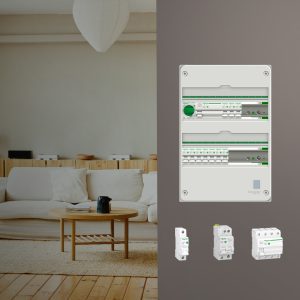In my previous post in my series, I covered the importance of continuous monitoring of electrical equipment to prevent fires and equipment failures – not just to minimize the damage they cause once they’ve occurred. In this post, I’ll be discussing how those monitoring capabilities are getting built “natively” into today’s circuit breakers and electrical panels to begin supplying operational data from the day they’re first installed.
Such new capabilities can benefit insurers by reducing risk. They also can aid testing, inspection, and certification (TIC) providers by enabling value-added services to support customers all year round, not just during annual inspections. And, they are continuing to advance, promising to provide an even fuller view into electrical operations in the future.
 The products enabling new services
The products enabling new services
Of course, usage sensors that can track voltage, current, and kilowatt-hours at the circuit level have been around for some time. However, the latest devices provide more data on several factors related to electrical equipment’s operating conditions. For example, they can detect overheating, moisture, arc fault, poor power quality, and partial discharge, among other issues.
Where this kind of monitoring has been available in the past, its installation has been complicated, requiring the services of systems integrators. As a result, it was reserved for high-end, super-critical applications. Now, breakers and electrical panels are available with that built-in monitoring feature, with easy configuration by an electrician or even end users, making this valuable feature available in all sorts of buildings.
Context matters
Today’s options for boosting the intelligence of building electrical systems don’t end with smarter breakers and panels. Those equipment-integrated sensors can be networked into a broader system that includes cloud-based analytics. And locally installed apps give users the context they need to understand what sensor data means.
Based on the industrial internet of things (IIoT), this approach can link information on equipment conditions to other data related to its location, maintenance records, insurance inspection status, and other related factors. This information is all designed with users in mind. They can now access it through a simple scan of a QR code label placed on the equipment and through apps designed to bring information on a facility’s dispersed electrical components together into a single interface on a laptop or mobile device.
Built-in connectivity today
The enabling connectivity technology for many of these capabilities is called LPWAN (for “low-power wide-area networks”). This advance offers long-range wireless telecommunication at the site level. My colleagues Marc Burger and Emmanuel Dreina provided an overview of LPWAN in their recent blog post, “How LPWAN Enables Smart Power Distribution Systems.”
Schneider Electric is offering to its customers this super simple connectivity into a number of its product ranges today:
- PrismaSeT P Active low-voltage switchboards feature native connectivity to enable faster commissioning and ongoing monitoring. They come with a gateway integrated into the electrical panel, allowing up to 15 wireless sensors to be connected to the cloud.
- Acti9 Active VigiARC breakers offer inbuilt connectivity to provide all-in-one protection for people, assets, appliances, and circuits through advanced visibility with pre-alarms, alarms, remote monitoring, advanced analytics, and diagnostics.
- Easergy TH110 wireless sensors enable continuous thermal-condition monitoring of all critical electrical bolted connections, including cables, withdrawable circuit breakers, and busbar connections. The Thermal Connect mobile app can communicate with the sensor and replace the need for periodic infrared scanning, and continuous measurement is also natively available.
- PowerLogic HeatTag devices can detect inside electrical panels early signs of insulation deterioration at a high level of sensitivity. Related data and alarms can be visualized locally by onsite facility personnel and uploaded to the cloud to inform facility personnel when not on-site and expert advisory services (such as TIC providers), so maintenance can occur before dangerous conditions arise.
On the horizon are even more advanced “digital twin” technologies that will build on today’s cutting-edge sensors and analytics to provide a virtual model of electrical equipment as it is currently operating. This will enable facility managers and others to see exactly what’s going on inside a panel without having to open its doors, even from remote locations.
Wide-ranging benefits
The value of such shared visibility on smart sensors, breakers, and electrical panels is evident across the risk-management value chain, from facility owners and managers to insurers and TIC providers. Facility owners can expect improved uptime and greater assurance of business continuity. Insurers will see obvious opportunities for reducing their risk exposure. And TIC providers will have a greater ability to offer clients access to their electrical expertise far beyond their typical once-a-year thermal inspections.
Visit our EcoStruxure Power homepage for more on the advantages of IIoT-connected power systems. Otherwise, you can reach out to your local customer support office.



